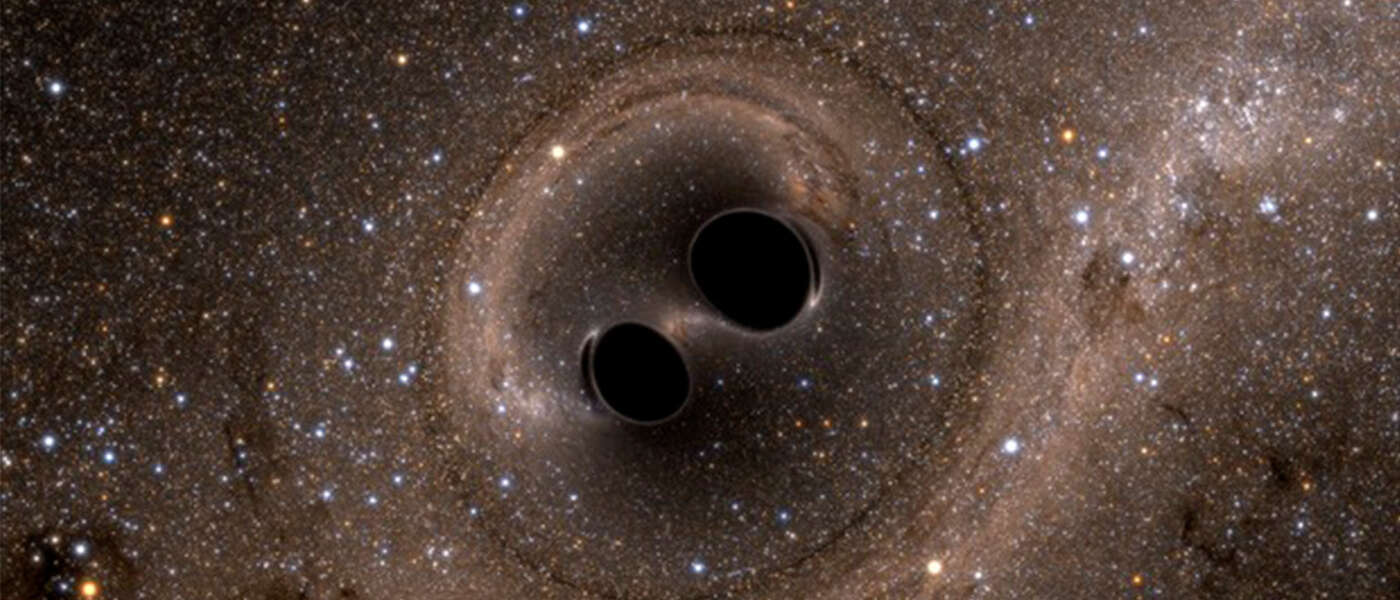How did our Milky Way galaxy evolve? And how fast is the universe expanding – and what might ultimately happen to it?
Scientists worldwide probing these cosmic questions may benefit from a recent study of collisions of supermassive black holes by University of Guelph physicist Dr. Huan Yang.
The study model provides a clearer picture of how galactic and black hole collisions occur, said Yang, whose Department of Physics is part of the College of Engineering and Physical Sciences. That information will help scientists using a global array of radio telescopes to understand what happens during these galaxy-shaking smash-ups and offer clues about just how rapidly the universe is expanding.
“We want to understand how we have the universe we have right now,” said Yang, who divides his studies between U of G and the Perimeter Institute for Theoretical Physics in Waterloo, Ont.
He described the model in a recent paper in The Astrophysical Journal co-authored by Yun Fang, a researcher at the Kavli Institute for Astronomy and Astrophysics at Peking University in Beijing.
Radio, gravitational waves point to presence of supermassive black holes

Most galaxies, including our Milky Way, have a supermassive black hole at their centre. A black hole weighs a few times the mass of the sun, while a supermassive black hole usually weighs as much as millions of suns.
Supermassive black holes form when two galaxies collide or two black holes approach each other, explained Yang. Earlier this year, astronomers reported the first-ever image of a single supermassive black hole at the centre of our galaxy.
Scientists cannot view these distant objects and events directly. But they can detect signs of black holes merging or orbiting each other at extreme speeds by recording electromagnetic signals like radio waves and gravitational waves.
Radio wave signals are picked up by the Event Horizon Telescope (EHT), which is an array of synchronized telescopes in nearly a dozen locations worldwide. Gravitational waves – basically ripples in space-time sent across the universe – have been picked up by special detectors in the United States and Italy.
The signals provide only a fuzzy picture of what these cosmic-sized events look like. Yang’s simulations aim to help scientists get a clearer image by identifying how celestial bodies orbit one another.
A sharper focus on the fate of the universe
His model aims to capture so-called orbital parameters of supermassive black hole binaries. What are those parameters?
Like a satellite circling Earth, one black hole may orbit another at a tilted angle called the orbital angle. How often one object circles the other is measured by orbital frequency. Eccentricity refers to the deviation of an orbit from a perfect circle, such as the elliptical orbit of Earth around the sun.
Being able to capture these and other features of a supermassive black hole can enable scientists to get a sharper image of the orbiting bodies and their structures. “Seeing” these objects and understanding more clearly how binaries form may help in interpreting long-past cosmic happenings, including the evolution of our galaxy.
Yang said his modelling suggests that galactic mergers are far from rare, at least measured over cosmic time.
“Our simulations pave the way for detecting supermassive binary black holes and understanding their connection to galaxy mergers, which probably happened in our own galaxy as well,” said Yang. Widening the scope, he added, “We want to understand how the universe evolved.”
Looking to the future, he said gravitational wave measurements of the mass of a binary system could help determine how fast the universe is expanding. That measure, called the Hubble constant, may help in predicting the fate of the universe.
Yang said his theoretical findings will be used by astronomers and astrophysicists tracking gravitational waves as well as researchers using the next generation of radio telescopes.
“The EHT collaboration is talking about upgrading the network to achieve 10 times better sensitivity,” he said. “The next-generation EHT will target supermassive black hole binaries. This paper will tell scientists how to extract the orbital parameters to help interpret and understand what they see.”
This research was supported by the Natural Sciences and Engineering Research Council of Canada and the Perimeter Institute as well as the National Science Foundation of China and the China Postdoctoral Science Foundation.
Contact:
Dr. Huan Yang
hyang10@uoguelph.ca
